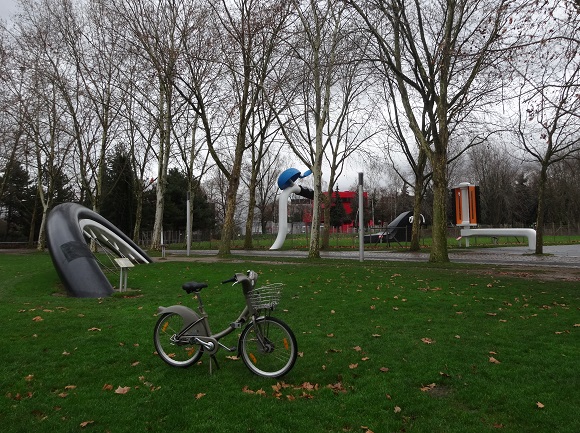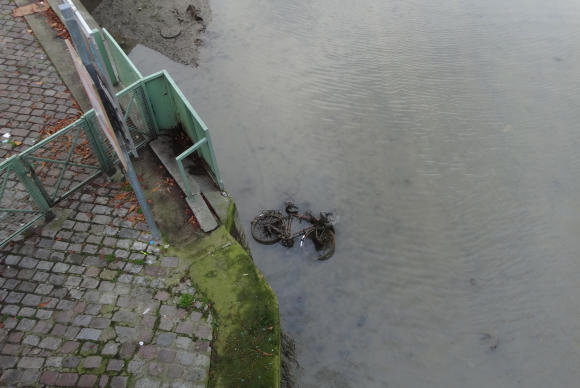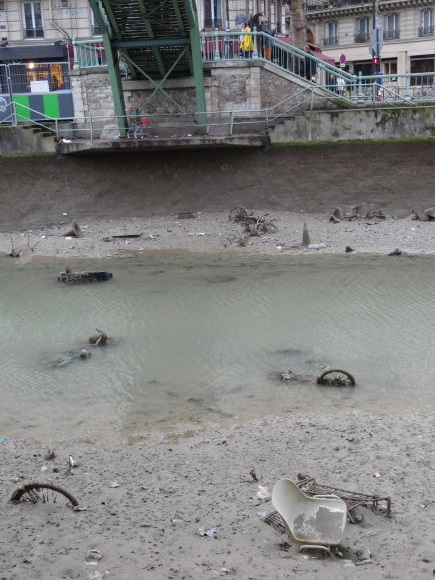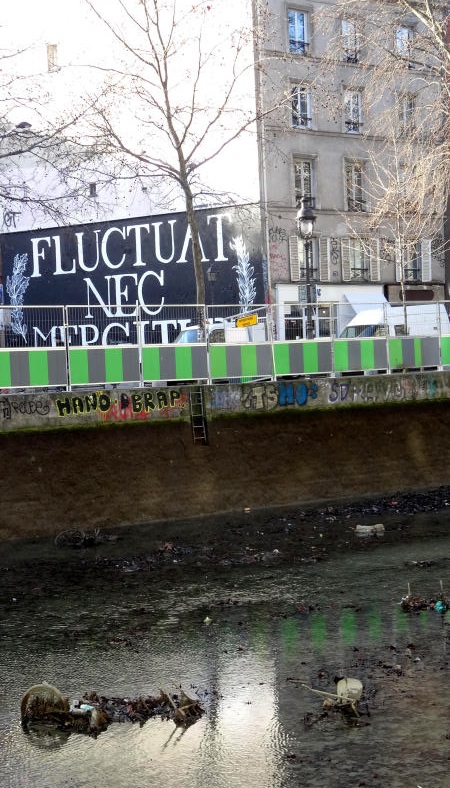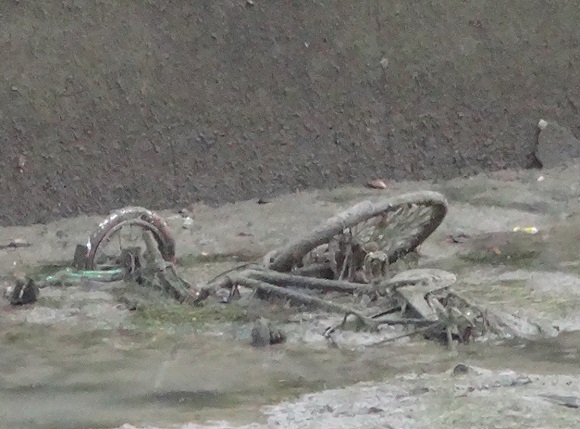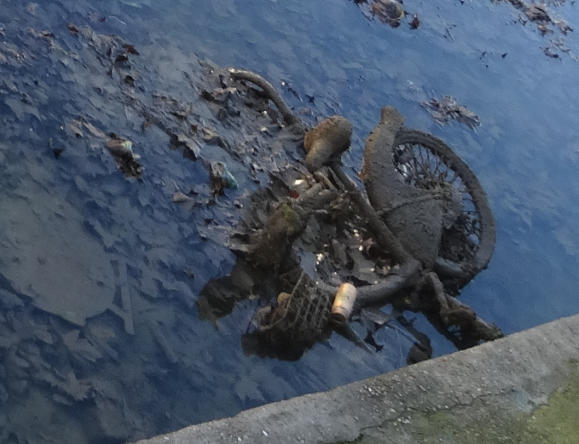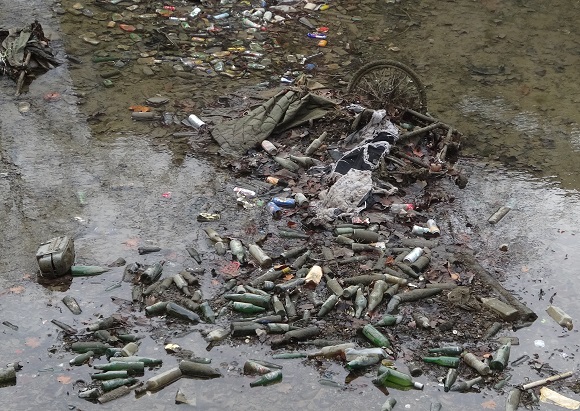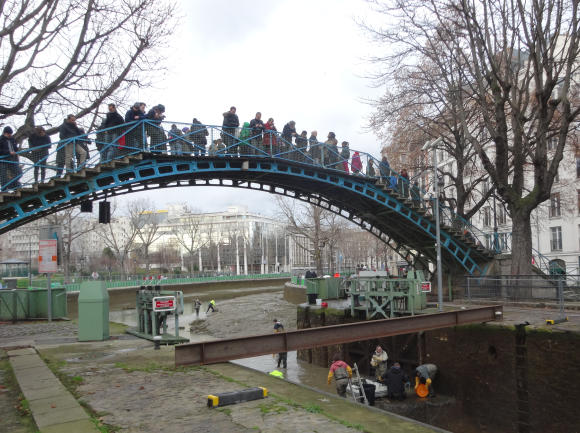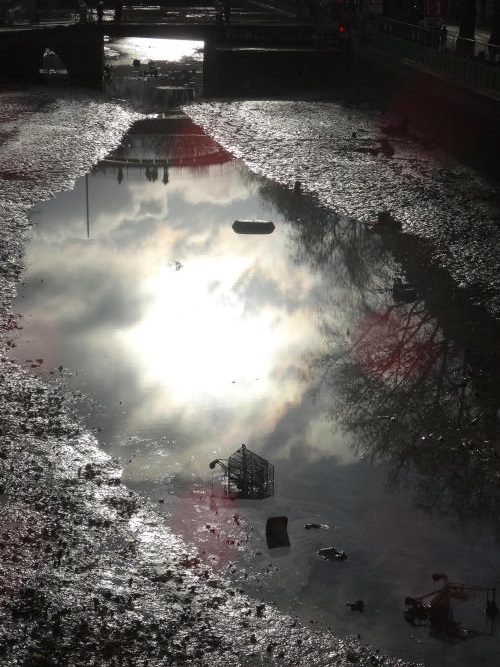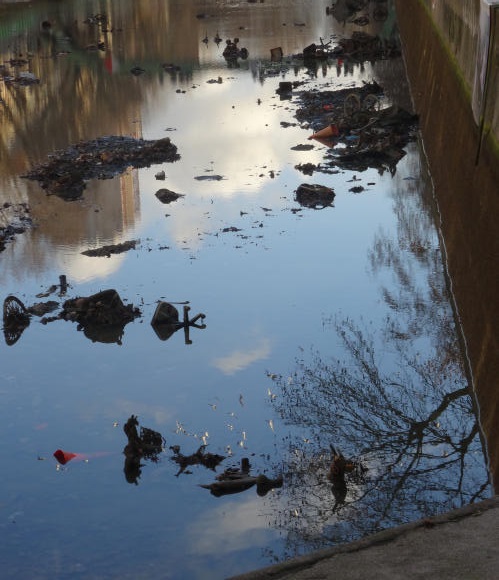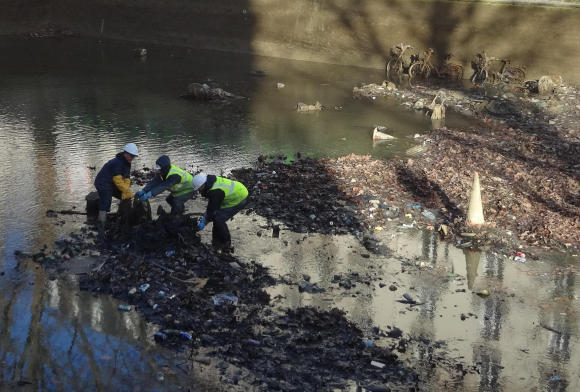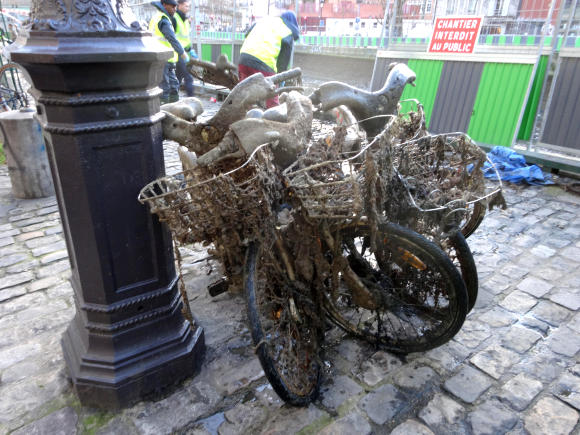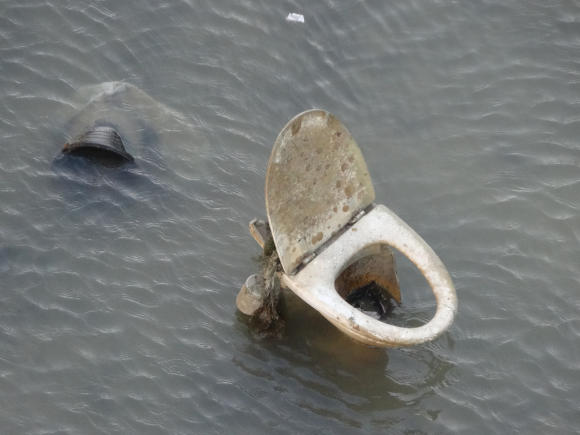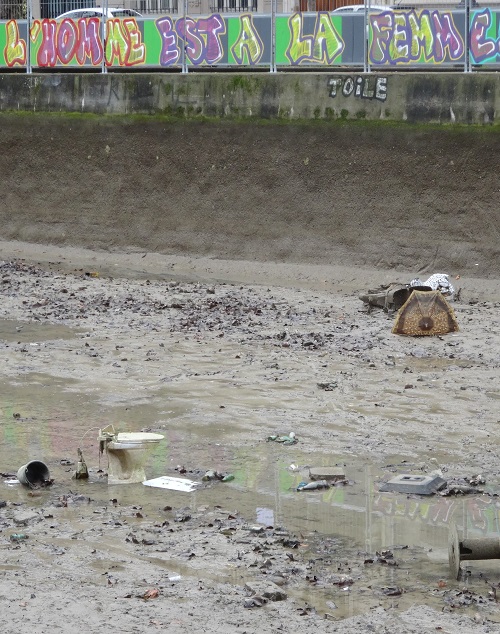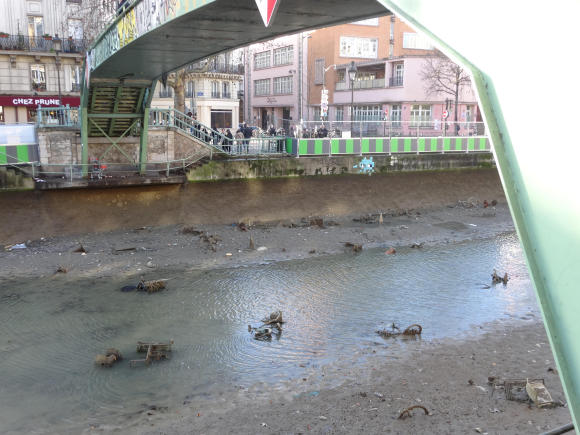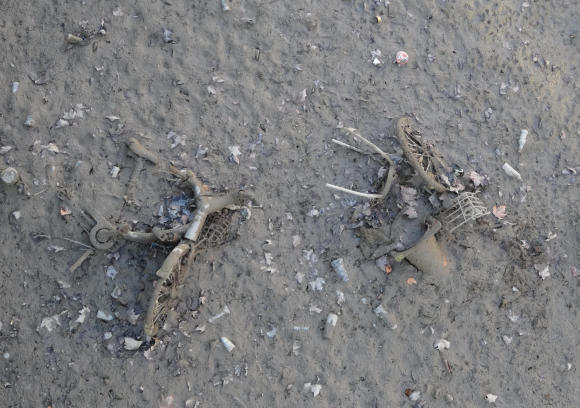
In a startling and macabre discovery, archeologists in Paris discovered this week what appears to be a mass bicycle graveyard on the site of a portion of Canal Saint Martin in the 10th arrondissement.
A National Institute for Preventive Archeological Research (INRAP) spokesman called it “the most significant archeological find in Paris in the past 14 years, both for its size and its singularity.”
The discovery was made by accident when the Société du Grand Paris unearthed a wheel while conducting preliminary soil analysis for a new suburban rail line that would follow the ancient canal routes out to the northeast suburbs as part of the long-term Paris Métropole project.
The canal site, according to INRAP, was the resting place for 182 bicycles, 55 chairs, 51 caddies and 23 motorcycles and scooters. Urban biologists are also excited by the opportunity to drain the canal to conduct the dig since in the process it was discovered that 17 species of fish thrived in the murky water, including a carp weighing over 35 pounds (16 kilos) and a catfish measuring nearly 4 feet (1.2 meters).
Historians are hoping that the new find will provide clues to understanding the presence of a series of bicycle-related monuments unearthed in 1990 two miles further along the canal route in what is now Parc de la Villette. After 25 years of study, those monuments, collectively known as The Buried Bicycle (La Bicyclette Ensevelie), have retained much of their mystery.
Theories vary as to the meaning of the Scandinavian-sounding inscription “Claes Oldenburg Coosje Van Bruggen” found on the artefacts. While some surmise a link with the Viking invasions of the 9th century, others believe the site to be the work of a cult dedicated to Saint Catherine of Alexandria who was to be executed on a spiked wheel that miraculously broke when she was placed on it. Joan of Arc claimed that Catherine told her to rid France of invaders.
The fact that the newly discovered bicycle cemetery is quite removed from The Buried Bicycle “raises more questions than it answers,” said INRAP’s chief cycle archeologist Dominique De Roue in an interview over coffee at the café and restaurant Hôtel du Nord. “But due to the scope of this extraordinary find some of those answers may now be within reach.”
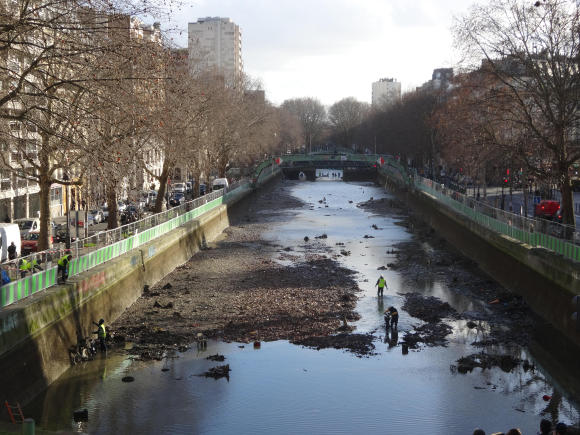 Asked how the discovery of the bicycle cemetery compares with the well-arranged mass grave unearthed last winter under the Monoprix grocery store in the second arrondissement, De Roue said, “We were previously well aware that the Trinity Hospital had been on that site in the Middle Ages. So while the density of skeletons was unexpected, we were not surprised to find a burial site in the area. In this case, however, while we were aware of The Buried Bicycle and of anecdotal evidence of missing bicycles throughout the history of Paris, we had no conclusive evidence until now that Parisians had specifically designated a site for the burial of their two wheelers. We’re all very excited by the discovery.”
Asked how the discovery of the bicycle cemetery compares with the well-arranged mass grave unearthed last winter under the Monoprix grocery store in the second arrondissement, De Roue said, “We were previously well aware that the Trinity Hospital had been on that site in the Middle Ages. So while the density of skeletons was unexpected, we were not surprised to find a burial site in the area. In this case, however, while we were aware of The Buried Bicycle and of anecdotal evidence of missing bicycles throughout the history of Paris, we had no conclusive evidence until now that Parisians had specifically designated a site for the burial of their two wheelers. We’re all very excited by the discovery.”
Unlike the medieval Trinity Hospital cemetery beneath the grocery store, which was visible only to specialists, the St Martin bicycle graveyard is an open excavation visible from the canal’s cobblestone sidewalk and metal bridges.
Adding to the macabre nature of the find, some of the bicycle cadavers have been so well preserved in the sediment that vultures, rarely seen in Pairs since the Franco-Prussian War, have appeared at the site.
Standing on the edge of the vast excavation site as a team of forensic archeologists worked below, Jean-Pierre Durcel, a professor at the Sorbonne and renowned expert on the 16th-century War of Locomotion, who is member of the dig’s scientific committee, said, “While it’s too early to speak definitively of any relation between this site and the War of Locomotion, there is a certain logic to it, given the location near Saint Louis Hospital, which was built soon after the end of the war period. The presence of a bicycle cemetery here would appear to confirm the hypothesis explored in my essay ‘Circular Lives: The Wheels of Monarchy, 1570-1610.’”
In that essay, Ducel seeks to explain why Henri III, unable to sooth tensions between velopedists and quadropedists, was assassinated in 1589, an event that brought an end to the Valois dynasty and temporarily halting dual-wheel development in France. His successor, Henri IV, was a 4-wheeler who eventually converted to bi-wheelism but was nevertheless assassinated in turn by a radical velopedist in 1610 while riding in a horse-drawn four-wheel “voiture” or vector.
Monique Guidon, a specialist on medieval executions, said over tea and cake at La Chambre aux Oiseaux, that the gravesite should rather be seen in relation with the presence nearby of the Gallows or Gibet of Montfaucon, once one of the most chilling sites in the countryside of Paris. The gallows were in use for some 350 years beginning in the late 12th century.
“They were just up the road from here,” she said. “It would have been reasonable to pass this way when wheeling criminals to the site of their execution. People have been calling this a ‘bicycle cemetery’ but it’s quite possible that the site contains a variety of wheeled vehicles and carts.”
A relationship between the cemetery and an as-yet-undated sign that was discovered in November during restoration of a piece of the city’s old ramparts is also being studied.
On a visit to the site before going to lunch at Les Enfants Perdus, Paris Mayor Anne Hidalgo, declared the site “further evidence that bicycles have long been a part of the life of the city.” Noting that some of the bicycles appear to have been “tortured,” the mayor said, “We must honor those that came before us and continue to fight for the rights of non-motorized Parisians.”
She was referring to the twisted cadavers of some of the bicycles. Several firearms have also been discovered in the upper strata of the excavation, though archeologists warn that it is too early to draw conclusions as to their relationship with the bicycles, tortured or not.
Opposition leader Nathalie Kosciusko-Morizet denounced Mayor Hidalgo’s “politicization of an archeological discovery.” “Parisians feel a lack of security,” she said before going to lunch at Philou, “and the mayor is only interested in re-interpreting history in such a way as to convince citizens that the fight against terrorism requires that bicycle lanes be extended.”
Radical leftist and extreme rightist parties both accused the government of timing the find to draw attention away from “the real problems confronting France” so as to promote a series of conference that will mark the Ile-de-France (Paris Region) Archeology Day on January 16. While some on the left said that the 9.5 million euros earmarked for the excavation would be better used to help house Syrian refugees fleeing the Israeli occupation, some on the right called for it to be used for better controls at the border between France and Turkey.
A forensic archeologist familiar with the dig, who requested anonymity due to the political nature of the discussion, acknowledged that some of the bicycles show signs of torture that may be related to political or cultural tensions of the time. He said that it was too early to know whether those tensions were local in nature or national or perhaps even international given that the site lies on a Roman trade route connecting Paris with what are now Belgium, Luxembourg and Germany.
Interpretation of the exact nature of the vast gravesite is further complicated by the presence in various strata of hundreds, perhaps thousands of recipients of what Georgio Manubrio, an Italian specialist on beverages from antiquity who is part of the INRAP team, said likely contained beer and wine.
Over coffee at Canaletto Caffè, Manubrio said, “Given the provenance of the amphorae and other recipients I’ve seen at the site Parisians at the time favored very poor quality beverages. I dare say that what they consumed at the time would be considered undrinkable today.”
“A bit like French coffee today,” he added.
Vélorution, an association militating against motorized vehicles (“Turn off your engines! Breath happiness!”) has begun daily demonstrations on the bridges overlooking the excavation site and as called for a massive demonstration on Sunday afternoon, when portions of Quai de Valmy and Quai de Jemmapes, the roads along the ancient canal, are closed to motorized traffic. To support their efforts, Vélorution will be holding a fundraising event at Le Comptoir Général following the demonstration.
A spokeswoman for district mayor of the 10th arrondissement said that an exploratory committee was being formed to study the possibility of obtaining UNESCO World Heritage Site listing for the bicycle cemetery, either in its own right or by requesting the extension of the listing of the banks of the Seine to the banks of the canal.
“The beauty and historical value of the site deserves protection,” she said.
The effort of district mayors to spearhead World Heritage recognition is not unprecedented as Delphine Bükli, district mayor of the 9th arrondissement, has recently sought UNESCO World Heritage status for the rooftops of Paris.
Asked if UNESCO listing of the bicycle cemetery might adversely affect future evolution of the area, the spokeswoman said, “We will not allow terrorists to affect the quality of life in the 10th arrondissement,” presumably referring not to UNESCO but to the November 2015 terrorist attacks which took place at Le Petit Cambodge and Le Carillon just 100 yards from bicycle cemetery excavation site.
District Mayor Rémi Féraud declared “The canal area will be ready for picnickers in the spring” before headed to have lunch at Haï Kaï.
Archeologist have been working at the dig for several days now and are currently in the process of removing the bicycle cadavers and remnants so that they can be studied under appropriate conditions using the latest scientific equipment. The company JCDecaux, a specialist in Jurrasic velopedes, has obtained the contract for doing DNA testing on the bicycles from that era.
It is as yet unclear as to where all of the bicycle cadavers would go after analysis, but Jean-Francois Decaux, co-CEO of the namesake group, said that by agreement with the City of Paris his company the remains of those showing no signs of torture from the era of its speciality will be placed on display at various locations in the city.
As to those showing signs of torture or from other periods in history, the City of Paris in collaboration with the Ministry of Culture would decide where they would be placed.
Reached by phone prior to her appearance on the Channel 2 8pm news, Fleur Pellerin, Minister of Culture and Communication, said, “Unfortunately my schedule as minister hasn’t allowed me to visit the excavation site. Nevertheless, I’m well aware that the bicycle cemetery is an important part not only of the history of Paris but of our national heritage and therefore I will do everything in my power to ensure that it is preserved digitally.”
The association Friends of the Carnavelet Museum is pleading in favor of bringing some of the remnants—tortured bicycles, beverage containers, possibly a firearm or two—to that museum, which is concerned with the history of Paris. However, the museum’s director, Valérie Guillaume, who also oversees the Catacombs, said over an early-evening pint at The Cork and Cavan that the Catacombs may be a more appropriate location to place the bicycle cadavers.
Archeologists were initially unable to identify an oddly shaped seat-like object at the gravesite.
But fresco specialists soon uncovered the words “Homme,” “Femme” and “Toile” on a supporting wall leading to the conclusion that the object is a toilet for cemetery workers, which apparently included women.
The owners of Le Polidor, Le Baron Rouge and other historical-minded eating and drinking establishments in Paris have offered to remove and restore the curious object at their own expense and to place on display in their own WC.
Said one business owner, who requested anonymity while negotiations are ongoing, “Though the modern technology of the hole in the ground is most practical and hygienic, we like the idea of adding a historical and retro element from a time, unimaginable as it may seem to us today, when woman actually dared to sit down to pee in a public water closet. Since I’m not a historian myself I don’t yet know how to properly clean it, but I’ve reached out to toilet specialists at the University of Nantes and will be working with them to develop instructions to ensure both proper use and proper maintenance. Some of our regular clients may resist using it, so we’ll continue to provide the modern alternative of the hole in the ground. Our international visitors will certainly get a kick out of it.”
While the excavation has been drawing numerous curiosity seekers and Instagrammers, some visitors to the neighborhood are clearly moved by the sight.
Sitting at a café table outside Chez Prune, 24-year-old Emilie Cuissard said, “To think that bicycles have died and even been tortured so close to the three bicycle shops in the neighborhood…”
Her eyes tearing as she rolled a cigarette, she said “It makes me proud to be a Parisian.”
* * *
Further information about the bicycle cemetery and the archeological dig see here.
Photos and text © 2016, Gary Lee Kraut



